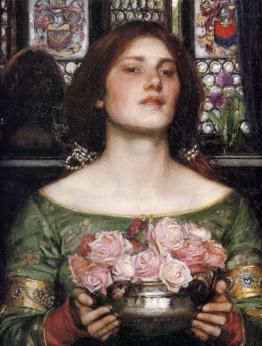 "A small pocket-book of this time [1866] contains a note made by Edward from a canal-bridge in a poor quarter of the city, which nearly thirty years afterwards he developed into the background of his "Aurora." The main outlines of building and canal are preserved in the picture, and Aurora with her cymbals comes lightly stepping along a waterside path from which in the original sketch a woman stoops to bathe her baby, but the canal has changed into an arm of a river and the houses have been welded into the long, low storage-places of a wharf, crowned by a great church lifted up against the sky." - from Memorials of Edward Burne-Jones by Georgiana Burne-Jones
"A small pocket-book of this time [1866] contains a note made by Edward from a canal-bridge in a poor quarter of the city, which nearly thirty years afterwards he developed into the background of his "Aurora." The main outlines of building and canal are preserved in the picture, and Aurora with her cymbals comes lightly stepping along a waterside path from which in the original sketch a woman stoops to bathe her baby, but the canal has changed into an arm of a river and the houses have been welded into the long, low storage-places of a wharf, crowned by a great church lifted up against the sky." - from Memorials of Edward Burne-Jones by Georgiana Burne-JonesAurora, 1896
Queensland Art Gallery
"Aurora, the Roman mythical personification of dawn, is here depicted barefoot and with cymbals to wake the sleeping city as a soft dawn light rises behind rooftops and distant trees. ... The face of Aurora in this work is an idealised portrait of Bessie Keene, one of the artist's models." - Link to Queensland Art Gallery note
Reframing Burne Jones 'Aurora' (1896) - an article from the Queensland Art Gallery (Link)











































































